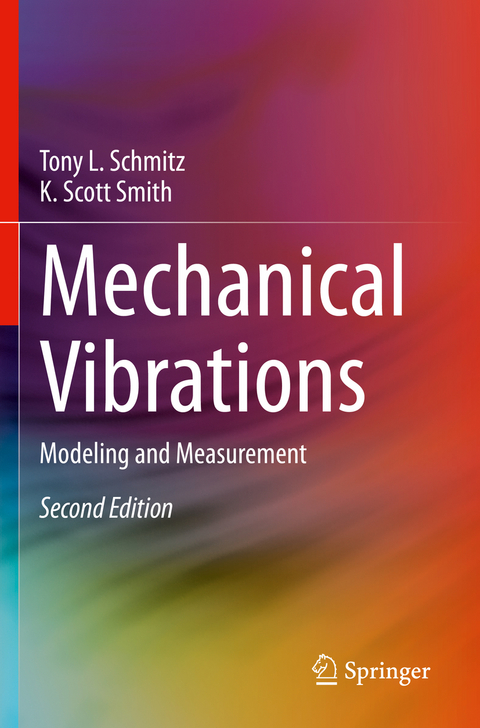
Mechanical Vibrations
Springer International Publishing (Verlag)
978-3-030-52346-6 (ISBN)
- Presents a clear connection between continuous beam models and finite degree of freedom models;
- Includes MATLAB code to support numerical examples that are integrated into the text narrative;
- Uses mathematics to support vibrations theory and emphasizes the practical significance of the results.
lt;b> Tony L. Schmitz received his BS in Mechanical Engineering from Temple University in 1993, his MS in Mechanical Engineering from the University of Florida in 1996, and his PhD in Mechanical Engineering from the University of Florida in 1999. He completed a post-doctoral appointment at the National Institute of Standards and Technology (NIST) and was then employed as a Mechanical Engineer from 1999-2002. During this time, he was also a lecturer at Johns Hopkins University. Dr. Schmitz accepted an appointment in the University of Florida's Department of Mechanical and Aerospace Engineering (UF MAE) in 2002 and joined the Mechanical Engineering and Engineering Science Department at the University of North Carolina at Charlotte in 2011.He accepted a joint faculty position between the University of Tennessee, Knoxville (UTK) and Oak Ridge National Laboratory (ORNL) in 2019. The appointment is a 50/50 split position between the Mechanical, Aerospace, and Biomedical Engineering department at UTK and ORNL's Manufacturing Demonstration Facility. Dr. Schmitz focus is on manufacturing research with an emphasis on machining dynamics. His professional recognitions include the 2019 SME Frederick W. Taylor Research Medal, 2019 UNC Board of Governors Award for Teaching, 2019 Best Presentation ASPE Annual Meeting, and the 2019 NAMRI/SME Outstanding Paper (47th North American Manufacturing Research Conference).
K. Scott Smith leads the Oak Ridge National Laboratory's advanced machining and machine tool research, focusing on developing systems, processes, sensors and controls. Prior to joining ORNL, he was a professor and chair of mechanical engineering at the University of North Carolina at Charlotte. He was honored by American Society for Mechanical Engineers with the William T. Ennor Manufacturing Technology Award for his "innovations in the field of machining dynamics that have been commercially implemented, leading to significant improvements in machine tool performance and enabling the creation of thin monolithic machined structures in a variety of industries." Prior to his work at the University of North Carolina, he served as the assistant director for technology at the U.S. Advanced Manufacturing National Program Office. He holds 11 patents and is one of 17 U.S. fellows of the International Academy for Production Engineering (CIRP). He earned his PhD in Mechanical Engineering from the University of Florida where his research focused on the dynamics of machine tools, vibrations, and machine design.
Introduction.- Single Degree of Freedom Free Vibration.- Single Degree of Freedom Forced Vibration.-Two Degree of Freedom Free Vibration.- Two Degree of Freedom Forced Vibration.-Model Development by Modal Analysis.- Measurement Techniques.- Continuous Beam Modeling.- Finite Element Introduction.- Receptance Coupling.- Advanced Receptance Coupling.- Appendix A: Beam Experimental Platform.- Appendix B: Orthogonality of Eigenvectors.
"The book is suitable for undergraduate students, researchers, and practicing engineers who are interested in developing an understanding of essential concepts in vibration analysis of mechanical systems." (IEEE Control Systems Magazine, Vol. 41 (2), April, 2021)
| Erscheinungsdatum | 31.10.2021 |
|---|---|
| Zusatzinfo | XII, 430 p. 335 illus., 28 illus. in color. |
| Verlagsort | Cham |
| Sprache | englisch |
| Maße | 155 x 235 mm |
| Gewicht | 676 g |
| Themenwelt | Naturwissenschaften ► Physik / Astronomie ► Mechanik |
| Technik ► Maschinenbau | |
| Schlagworte | Continuous beam models • differential equation • Equation of Motion • Mechanical Vibrations • modal analysis • Modal Testing • Receptance coupling • System Dynamics • vibrations |
| ISBN-10 | 3-030-52346-2 / 3030523462 |
| ISBN-13 | 978-3-030-52346-6 / 9783030523466 |
| Zustand | Neuware |
| Haben Sie eine Frage zum Produkt? |
aus dem Bereich


